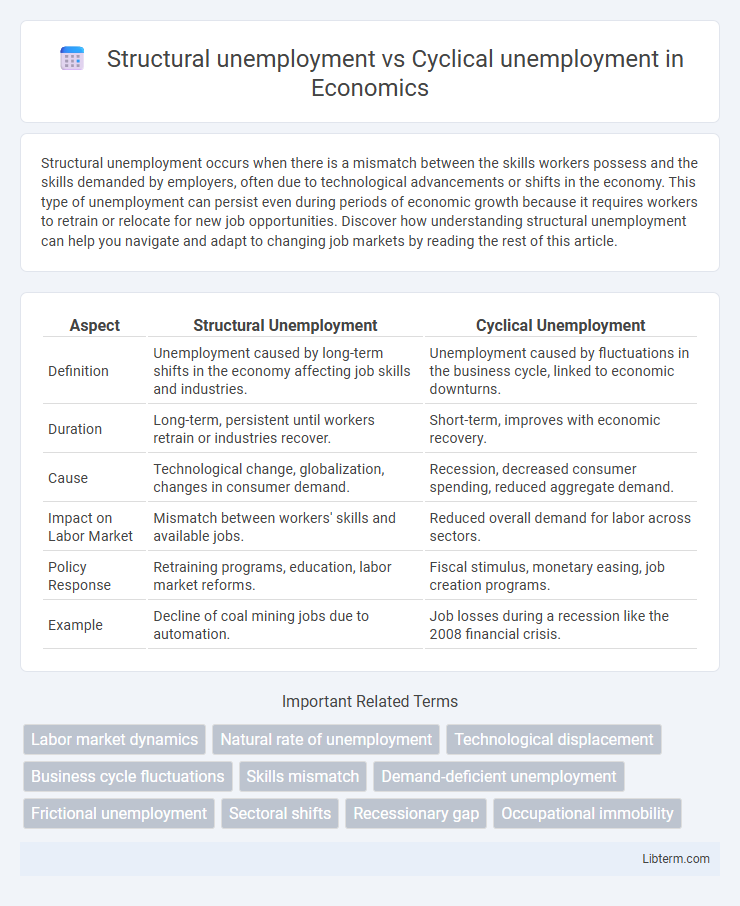Structural unemployment occurs when there is a mismatch between the skills workers possess and the skills demanded by employers, often due to technological advancements or shifts in the economy. This type of unemployment can persist even during periods of economic growth because it requires workers to retrain or relocate for new job opportunities. Discover how understanding structural unemployment can help you navigate and adapt to changing job markets by reading the rest of this article.
Table of Comparison
| Aspect | Structural Unemployment | Cyclical Unemployment |
|---|---|---|
| Definition | Unemployment caused by long-term shifts in the economy affecting job skills and industries. | Unemployment caused by fluctuations in the business cycle, linked to economic downturns. |
| Duration | Long-term, persistent until workers retrain or industries recover. | Short-term, improves with economic recovery. |
| Cause | Technological change, globalization, changes in consumer demand. | Recession, decreased consumer spending, reduced aggregate demand. |
| Impact on Labor Market | Mismatch between workers' skills and available jobs. | Reduced overall demand for labor across sectors. |
| Policy Response | Retraining programs, education, labor market reforms. | Fiscal stimulus, monetary easing, job creation programs. |
| Example | Decline of coal mining jobs due to automation. | Job losses during a recession like the 2008 financial crisis. |
Understanding Structural and Cyclical Unemployment
Structural unemployment arises from fundamental shifts in the economy, such as technological advancements or changes in consumer demand, leading to a mismatch between workers' skills and job requirements. Cyclical unemployment occurs due to fluctuations in the business cycle, where economic downturns reduce overall demand for labor and increase job losses temporarily. Understanding these types of unemployment is crucial for developing targeted policies that address skill development and economic stabilization.
Defining Structural Unemployment
Structural unemployment occurs when there is a mismatch between workers' skills and the demands of the job market, often caused by technological advancements, changes in consumer preferences, or geographic shifts in industries. Unlike cyclical unemployment, which fluctuates with economic downturns and recoveries, structural unemployment persists even during periods of economic growth due to fundamental changes in the economy. Addressing structural unemployment requires retraining programs and education to align the workforce skills with emerging job sectors.
Key Causes of Structural Unemployment
Structural unemployment arises primarily from mismatches between workers' skills and job requirements, often driven by technological advancements, globalization, and shifts in industry demand. Key causes include automation replacing manual jobs, outsourcing to lower-cost countries, and changes in consumer preferences leading to the decline of certain sectors. This form of unemployment persists even during periods of economic growth, distinguishing it from cyclical unemployment caused by economic downturns.
Defining Cyclical Unemployment
Cyclical unemployment occurs when economic downturns reduce overall demand for goods and services, leading to job losses across various industries. This type of unemployment fluctuates with the business cycle, rising during recessions and falling during expansions. Unlike structural unemployment, which stems from mismatches between workers' skills and job requirements, cyclical unemployment is directly tied to temporary declines in economic activity.
Key Causes of Cyclical Unemployment
Cyclical unemployment primarily arises from fluctuations in the business cycle, where economic downturns lead to reduced consumer demand and decreased production. Key causes include recessions, declines in aggregate demand, and contractions in investment spending. During these periods, layoffs increase as companies adjust to lower sales, distinguishing cyclical unemployment from structural unemployment driven by mismatches in skills or technological changes.
Distinguishing Features: Structural vs Cyclical Unemployment
Structural unemployment arises from fundamental shifts in the economy, such as technological advancements or changes in consumer preferences, leading to a mismatch between workers' skills and job requirements. Cyclical unemployment occurs due to fluctuations in the business cycle, where demand for goods and services declines during economic downturns, causing widespread temporary job losses. Unlike cyclical unemployment, which tends to decrease as the economy recovers, structural unemployment often requires retraining or geographic relocation for affected workers.
Impacts on the Labor Market and Economy
Structural unemployment results from mismatches between workers' skills and job requirements, causing long-term labor market inefficiencies and reduced economic productivity. Cyclical unemployment, driven by economic downturns, leads to temporarily increased joblessness, lower consumer spending, and decreased GDP growth. Both forms increase government spending on social benefits and strain labor market flexibility, though structural unemployment poses more persistent challenges to economic recovery.
Policy Responses to Structural Unemployment
Policy responses to structural unemployment focus on enhancing workforce skills through retraining programs and education initiatives tailored to evolving industry demands. Governments often invest in job matching services and geographic mobility incentives to address mismatches in labor supply and demand. Unlike cyclical unemployment measures, these strategies aim for long-term labor market adjustments rather than temporary economic stimulus.
Policy Responses to Cyclical Unemployment
Policy responses to cyclical unemployment focus on stimulating aggregate demand through fiscal measures such as increased government spending and tax cuts, aiming to boost economic activity and job creation. Central banks implement monetary policies like lowering interest rates to encourage borrowing and investment, which helps reduce unemployment during economic downturns. Temporary programs such as unemployment benefits and job training also support workers until the economy recovers from cyclical fluctuations.
Long-term Outlook and Solutions
Structural unemployment results from fundamental shifts in the economy, such as technological advancements and changes in consumer demand, leading to skill mismatches that require retraining and education programs for long-term resolution. Cyclical unemployment arises from economic downturns and fluctuating business cycles, typically addressed through fiscal and monetary policies to stimulate demand and promote job growth in the short to medium term. Long-term solutions for structural unemployment focus on workforce adaptability and innovation, while cyclical unemployment management depends on stabilizing economic conditions.
Structural unemployment Infographic

 libterm.com
libterm.com